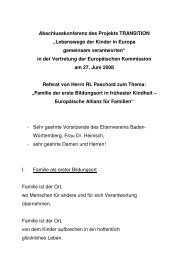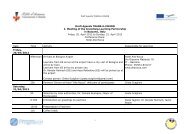Dokumentation Grundtvig 2
Dokumentation Grundtvig 2
Dokumentation Grundtvig 2
Sie wollen auch ein ePaper? Erhöhen Sie die Reichweite Ihrer Titel.
YUMPU macht aus Druck-PDFs automatisch weboptimierte ePaper, die Google liebt.
05-08-2008-II._Themen-3_Modul:<strong>Dokumentation</strong> <strong>Grundtvig</strong> 2 25.08.2008 16:42 Seite 103<br />
CURRICULUM - TRANSITION - Ausbildung zum/r Übergangsbegleiter/in für frühkindliche Bildungsprozesse - Socrates <strong>Grundtvig</strong> 1.1 Projekt<br />
II. Themen<br />
3. Modul „Entwicklungspsychologische Ansätze<br />
and psychiatrically impaired chronically assaultive<br />
young. Journal of Abnormal Psychology,<br />
106, 37-51.<br />
î Durkin, K. (1997): Entwicklungssozialpsychologie.<br />
In: Stroebe, W., Hewstone, G.,<br />
Stephenson, M. Sozialpsychologie. Eine Einführung<br />
(49-78). Berlin: Springer.<br />
î Eder, D. (1985): The cycle of popularity: Interpersonal<br />
relations among female adolescents.<br />
Sociology of Education, 58, 154-165.<br />
î Eisenberg, N., Fabes, R.A., Bernzweig, J.,<br />
Karbon, M., Poulin, R. & Hanish, L. (1993):<br />
The relations of emotionality and regulation<br />
to preschoolers` social skills and sociometric<br />
status. Child Development, 64, 1418-1438.<br />
î Elicker, J., Englund, M. & Sroufe, L.A.<br />
(1992): Predicting peer competence and<br />
peer relationships in childhood from early<br />
parent-child relationships. In: Parke, R.D. &<br />
Ladd, G.W.: Family peer relationships: Modes<br />
of linking, 77-106. Hillsdale, N.J.: Erlbaum.<br />
î Furman, W. & Buhrmester, D. (1985): Children`s<br />
perceptions of the personal relationships<br />
in their social networks. Developmental<br />
Psychology, 21, 1016-1024.<br />
î Furman, W., Simon, V.A., Shaffer, L. & Bouchey,<br />
H.A. (2002): Adolescents` working<br />
models and styles for relationships with parents,<br />
friends, and romantic partners. Child<br />
Development, 73, 241-255.<br />
î Gest, S.D., Graham– Bermann, S.A. & Hartup,<br />
W.W. (2001): Peer experience: Common<br />
and unique features of number of<br />
friendships, social network centrality, and<br />
sociometric status. Social Development, 10,<br />
23-40.<br />
î Hanna, N.A. (1989): Predictors of friendship<br />
quality and peer group acceptance at summer<br />
camp. Journal of Early Adolescence,<br />
18, 291-318.<br />
î Hatzichristou, C. & Hopf,D. (1996): A multiperspective<br />
comparison of peer sociometric<br />
status groups in childhood and adolescence.<br />
Child Development, 67, 1085-1102.<br />
î Haug-Schnabel, G. (2004): Verhaltensbiologische<br />
Erkenntnisse aus der Mutter-Kind-<br />
Bindungsforschung. Die Hebamme 17, 144-<br />
151.<br />
î Haug-Schnabel, G., Bensel, J. (2004): Vom<br />
Säugling zum Schulkind- Entwicklungspsychologische<br />
Grundlagen. kindergarten heute<br />
spezial. Freiburg: Herder.<br />
î Haug-Schnabel, G. Bensel, J. (2005): Grundlagen<br />
der Entwicklungspsychologie. Die ersten<br />
10 Lebensjahre. Freiburg: Herder.<br />
î Hinshaw, S.P., Zupan, B.A., Simmel, C.,<br />
Nigg, J.T. & Melnick, S. (1997): Peer status<br />
in boys with and without attention-deficit<br />
hyperactivity disorder: Predictions from<br />
overt and covert antisocial behavior, social<br />
isolation, and authoritative parenting beliefs.<br />
Child Development, 68, 880-896.<br />
î Keller, H. (1998): Entwicklung im Kontext.<br />
Entwicklungspsychologische Konsequenzen<br />
für eine außerfamiliäre Betreuung des Kleinkindes.<br />
In: Ahnert, L., Tagesbetreuung für<br />
Kinder unter 3 Jahren (164-172). Bern: Hans<br />
Huber.<br />
î Kruger, A.C. & Tomasello, M. (1986): Transactive<br />
discussions with peers and adults. Developmental<br />
Psychology, 22, 681- 685.<br />
î Ladd, G.W. & Pettit, G.S. (2002): Parenting<br />
and the development of children`s peer relationships.<br />
In: Bornstein, M., Handbool of<br />
parenting. Mahwah, NJ: Erlbaum.<br />
î Ladd, G.W., LeSieur, K. & Profilet, S.M.<br />
(1993): Direct parental influences on young<br />
children`s peer relations. In: Duck, S., Learning<br />
about relationships. London: Sage.<br />
î Laird, R.D., Pettit, G.S., Mize, J. & Lindsey, E.<br />
(1994): Mother-child conversations about<br />
peers: Contributions to competence. Family<br />
relations, 43, 425-432.<br />
î Langlois, J.H., Kalakanis, L., Rubinstein, A.J.,<br />
Larson, A., Hallam, M. & Smoot, N. (2000):<br />
Maxims or myths of beauty? A meta-analytic<br />
and theoretical review. Psychological Bulletin,<br />
126, 390-423.<br />
î Lindsay, E.W. & Mize, J. (2000): Parent-child<br />
physical and pretense play: Links to children`s<br />
social competence. Merrill-Palmer<br />
Quarterly, 46, 565-591.<br />
î Little, S.A. & Garber, J. (1995): Aggression,<br />
depression, and stressful life events prediction<br />
peer rejection in children. Development<br />
and Psychopathology, 7, 845-856.<br />
î Maszk, P. Eisenberg, N. & Guthrie, I.K.<br />
II. Themen 103











